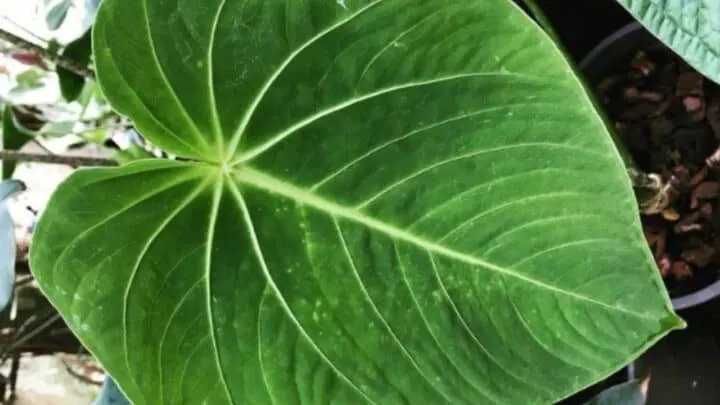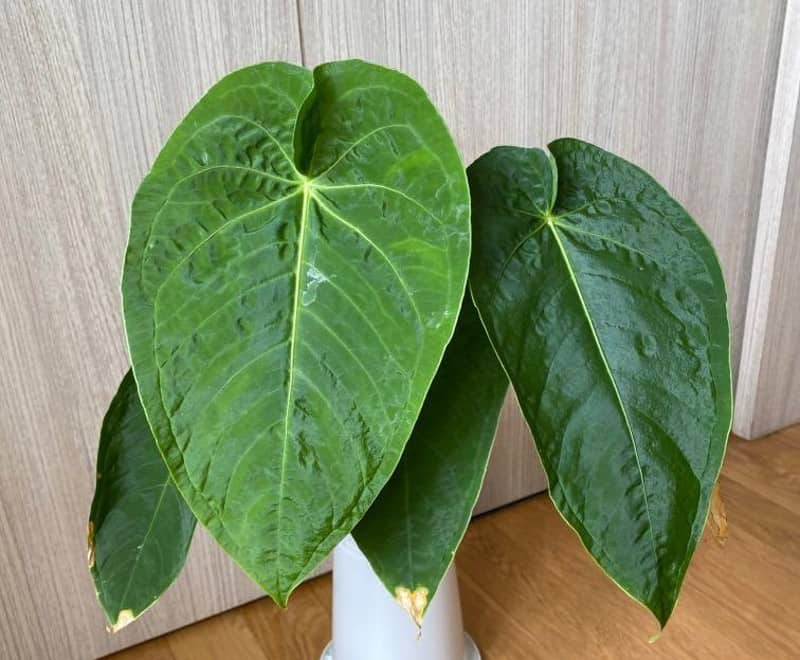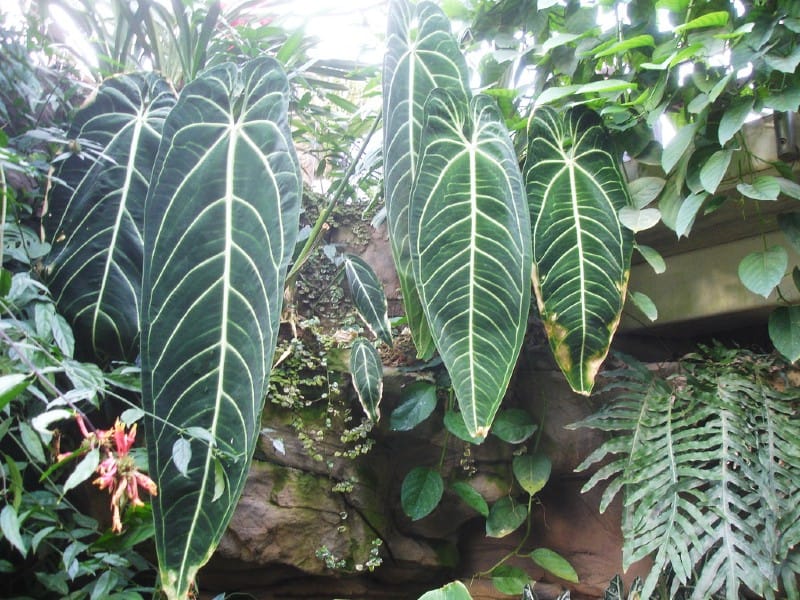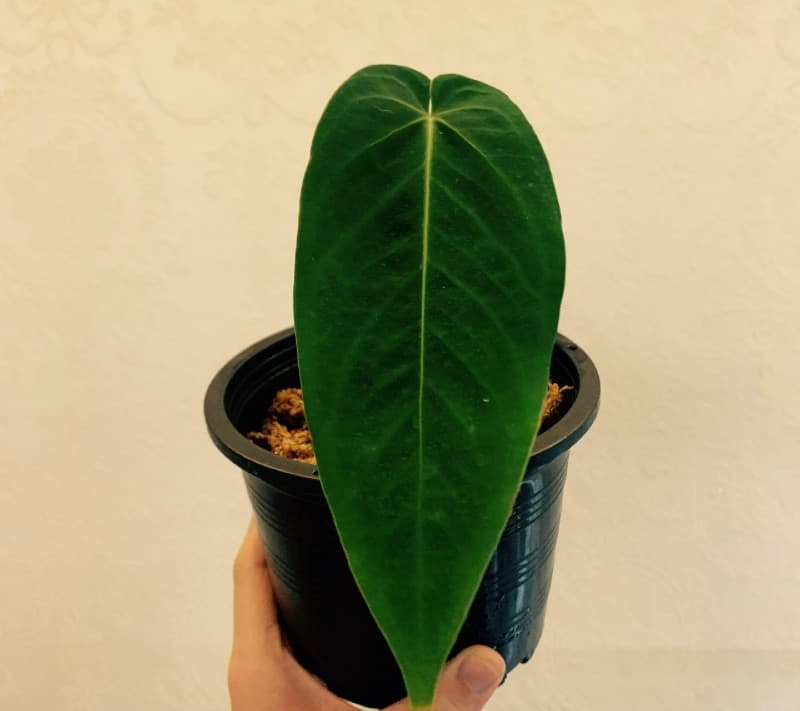No products in the cart.
Table of Contents
Anthurium waterburyanum is one rare plant not grown for its blooms but for its gorgeous display of dark green leaves.
While it is not its official name, people named it after Bette Waterburyanum, the original collector. Today, we will help you care for this Ecuadorian plant to help thrive in your home.
Anthurium Waterburyanum Care Basics

Anthurium waterburyanum grows in high humidity with warm temperatures. Thus proper maintenance is essential, and it needs the same supervision as other Anthurium plants to keep those ovate-shaped leaves mature and flourishing.
Here you can find a shortlist of information on how to take care of your captivating plant.

When you look at this particular Anthurium, there is not much scientific information available about it. But one thing we do know is that the care is similar to other plants in those species. So let’s get into the details.
Best Soil Conditions For These Indoor Plants
Anthurium waterburyanum is a true beauty, and to keep it that way, it helps to provide it with a well-draining potting mix. Thus, it would be best to create a home similar to where it lives in low elevations in the tropics.
To do this, it helps to mix equal parts of peat, perlite, and pine bark to be on the safe side. Alternatively, you can mix one part perlite with peat and two parts of the orchid mix. Providing this rare plant with this type of ground helps to keep the soil moist without waterlogging.
Ideal Lighting for Anthurium Waterburyanum

As it is a tropical plant growing in the canopy of taller trees, the best is to provide it with bright indirect light to germinate.
An excellent place for your plant is at a south-facing window where it can get enough light for those long velvety leaves. But make sure to place it at least four feet away from the window.
But if you do have north or west-facing windows, even better. Too much sun will scorch the foliage.
Watering Your Anthurium Waterburyanum
As with most houseplants in the Anthurium species, it does not need a lot of water. The crucial part is to provide it with moist soil.
The best time to water your indoor plant is when the top two inches of the soil becomes dry. Then, you can test it using your finger on the ground. If your finger is dry, then provide your plant with some water.
During winter, please keep checking the ground as it will not need a lot of watering as it goes dormant.
Temperature & Humidity
While your Anthurium can grow in low light conditions, it still needs sun and warm temperatures with high humidity. An ideal temperature range is 65 degrees F to 86 degrees F (18 degrees C to 32 degrees C).

If your tropical plant grows outside during winter, we recommend bringing it in as it is not frost-resistant. In addition, your exotic plant thrives in high humidity, and placing it in the bathroom or kitchen is ideal.
If you cannot provide it with the moisture needed, invest in a humidifier. This is a rare beautiful plant, and we don’t want to limit their needs based on what we can only provide.
Feeding Your Anthurium Waterburyanum
To ensure that your plant keeps its true beauty loved by all gardeners, you can provide it with high phosphorus levels in the feed. We recommend only using one-quarter strength diluted with water to prevent root burn.
A high phosphorus fertilizer keeps the foliage growing healthy, and you only need to do this once every two to three months in the growing season.
Propagating Your Anthurium
The best way to ensure you always have this rare plant is to propagate it through a stem cutting. Here are some easy steps you can follow:
First Step
From your main plant, cut off a stem anywhere. You can trim as many stem cuttings as you like depending on how many Anthurium waterburyanum you want to plant. You can cut above the soil level if you wish to as it will not die and start growing new leaves in the area.
Second Step
Take your stem cuttings and remove all the husks or brown leaves known as stipules as the plant only needs when new foliage emerges. Furthermore, removing it does not harm your plant. Remove all dead leaves that look yellow or brown. Also, remove any flowers present on the stem as it can take a lot of energy for your plants to grow.
Third Step
After removing the husks, keep at least two or more nodes present. So, the larger the cutting with aerial roots, the better chance it will grow well. Thus, having more leaves is a plus point and snipping the stem at the lower node helps the roots to grow faster.
Fourth Step ( optional )
Take the cut end and dip it into rooting hormones to help fasten the root growth. Using a powder rooting hormone, you can dip it into the powder before planting. You only need a few drops in the ground or the water container for liquid hormone. Another unique thing is to use cinnamon on the cut ends as it is an antimicrobial agent to keep it safe from fungal infections.
Fith Step
Next, place your cutting in a pot with perlite or orchid mix or a container of water. When you place your cutting in the ground, ensure that one node is under the soil while the others are above the foundation for the new leaf to form.
Sixth Step
As you know, these houseplants grow in high humidity levels. So the best is to place a plastic bag over the container to create a greenhouse effect. But if you are growing your plant in the water, this step is not needed.
Seventh Step
The final step is to be patient and wait up to six weeks to notice new growth and roots. Once the leaves form, you know it has grown roots. Now you can remove the plastic bag and care for your tropical plant as usual.
Growth Zone
The best place to grow your Anthurium waterburyanum is in the hardiness zones ten and higher when grown as an outdoor plant in a container. Yet, we recommend bringing it indoors during the winter.
Growing and Pruning
Your Anthurium waterburyanum can grow blooms, but it is recognized for its gorgeous large long velvety leaves. The leaves mature with an ovate shape and velvet texture. The foliage color varies from light to dark green. The leaves can grow up to 11-inches and a height of 15-inches.
An important note is when your plants become root-bound, you will have to repot them. The best way to know is when it starts to wilt after watering and if the roots circle out onto the soil. Another sign is when the water runs through the drainage holes or the roots poke out.
If root bound, your plant will die fast and the best time to place your plants in new pots is in spring. Another benefit is that your houseplant does not need much pruning. Instead, you can prune when you see dead leaves or infested.
We recommend not removing too much of your plant and only removing dead leaves, dead stems, or old leaves. Always use sterilized shears for pruning.
Anthurium Varieties and Similar Plants
Anthurium warocqueanum

The exotic plants grow huge leaves that are pendant and cardboard-like with dark green velvety blades.
Anthurium warocqueanum X waterburyanum

The plant is a hybrid between the waterburyanum and warocqueanum. It has very dark leaves that are velvety. This rare plant sells for a high price.
Magnificum x Warocqueanum

The hybrid is one of a kind with the young mangificum plant traits but grows to the size of the warocqueanum.
Anthurium Waterburyanum Diseases
As with most houseplants, your Anthurium waterburyanum can be the home of diseases and pests.
Root Rot
The fungal root rot can result from different fungi such as Armillaria mellea, Oomycetes, Clitocybe tabescens, and Fusarium. So, if your plant looks dull and starts to turn yellow or has stunted growth, it can be root rot. The best way to treat the condition is to remove your plant from the pot is to wash and snip the dead roots off.
Bacterial Blight
You will notice a small green spot looking as if it is water-soaked. As the spots enlarge, it starts to die and turn brown. Later you see a yellow ring forming and know it is bacterial blight. The disease is caused by misting the leaves, and you can use a fungicide.
Frequently Asked Questions
The plant is a hybrid between the two Anthurium plants. The leaves are very dark and velvety. This is one expensive plant.
The watermaliense is another Anthurium plant botanists have crossed with the Anthurium waterburyanum. A standout feature of the Anthurium watermaliense is its gorgeous dark-colored blooms. The hybrid is another expensive plant for rare plant collectors.
The tropical houseplant is challenging to find as it is part of the rare collection. Yet, the plant has lush foliage and makes expensive purchases compared to other plants.
Finding one at the local garden center is not always possible if you would like the Anthurium waterburyanum as an indoor plant. But you can find one here at Plantly to make it part of your tropical plant collection.
Whether you want to buy, sell, or simply reach out to other plant enthusiasts, Plantly is the right place to be!


